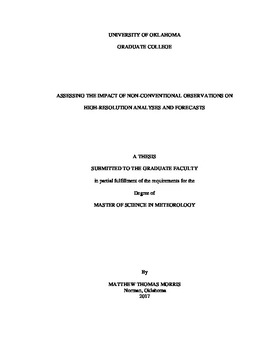| dc.description.abstract | A key recommendation of a 2009 report by the National Research Council (NRC) was for new mesoscale networks to be integrated with existing ones to form a nationwide “network of networks”. This recommendation originated in response to noted deficiencies in the U.S. mesoscale observing network. The report also recommended that research testbeds be established, such as the Center for Collaborative Adaptive Sensing of the Atmosphere (CASA) DFW Urban Demonstration Network, to ascertain the potential benefit of proposed observing systems.
In this work, non-conventional surface observations from Global Science & Technology (GST) Mobile Platform Environmental Data (MoPED), WeatherBug, Citizen Weather Observer Program (CWOP), and Understory Weather in the DFW Testbed are considered. Radar data include Terminal Doppler Weather Radars (TDWRs) and CASA X-band radars. The Advanced Regional Prediction System (ARPS) model is used to perform observing system experiments (OSEs) that are designed to assess the impact of the aforementioned networks. The three-dimensional variational (3DVAR) analysis system is used, along with the complex cloud analysis, to produce analysis increments every 10 minutes, which are then applied to the model forecast using incremental analysis updating (IAU). Experiments are performed on a supercell thunderstorm that impacted the DFW metroplex on 11 April 2016 with large, damaging hail. The analysis includes qualitative and quantitative comparisons of the forecast reflectivity fields, quantitative comparisons of model-derived hail with radar-observed hail, and surface-level verification of the temperature and dew point fields. The CASA radial velocity data offer positive benefit to the forecasted storm structure as noted in the simulated reflectivity, along with model-derived hail. However, the data appear to be detrimental when considering quantitative comparisons of the simulated reflectivity with observations. The inclusion of dew point temperature measurements from the non-conventional CWOP and WeatherBug networks resulted in a degradation in the forecasted dew point field. The analysis concludes with a brief comparison of the results for single-moment versus double-moment microphysics scheme sensitivity. Future work should assess the impacts of the non-conventional observations on a wider array of cases. | en_US |
